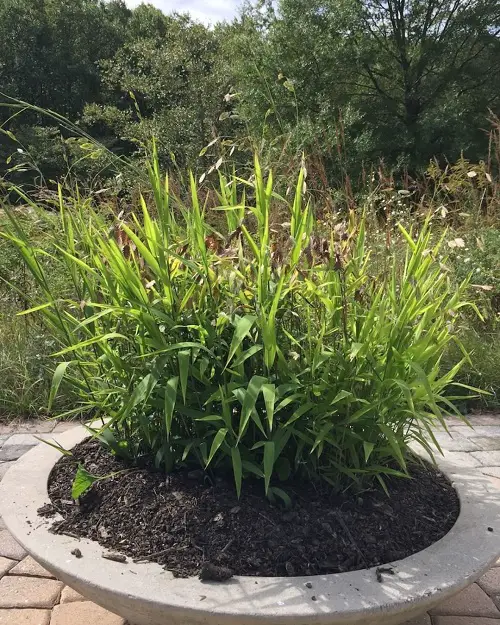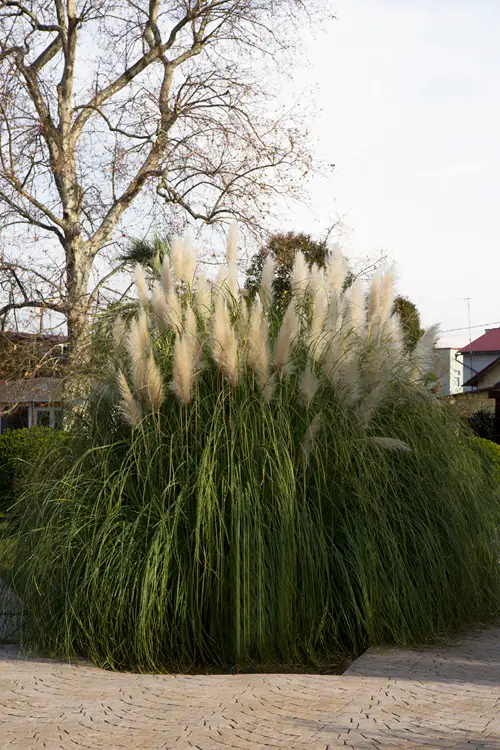Is your fall garden looking a little too barren? Here are the best Grasses that Stand Out in Fall and Winter!
Grow these frost-tolerant, cool-season grass varieties to spruce up your fall and winter landscape. While some are stunning, tall ornamentals, and some boost native biodiversity, nearly all these plants use far fewer resources than traditional lawns and thrive in the cold!
These grasses are ideal for filling out thinning garden beds and borders with hues that change through mild autumn weather, into the nippy holiday season and spring. And they grow well in pots and containers on compact patios too!
Grasses that Stand Out in Fall and Winter
1. Annual Ryegrass
Botanical Name: Lolium multiflorum
USDA Zone: 4-10
For a steady burst of green through winter, you need to plant the resilient, cold-hardy annual ryegrass. In fact, this plant thrives better in cold weather and cannot survive temperatures above 80 F (27 C).
This short-lived annual grows rapidly and adds fast color to old and new lawns in Northern and Southern lawns throughout the United States, especially as warm-season grasses go dormant.
2. Japanese Forest Grass

Botanical Name: Hakonechloa macra
USDA zones: 5-9
This shade-loving ornamental from Japan scales up to 1-3 feet but is cherished for its gorgeous mounds of bright green arching leaves that turn a blush pink in the fall. Japanese forest grass dies back in peak winter, but with ample mulch, you can coax it to withstand some frost.
For your fall and winter garden, check out varieties like ‘Benikaze,’ which turns a bright red in the fall, or the yellow-striped ‘All Gold’ and the chartreuse ‘Aureola.’
3. Golden Japanese Forest Grass
Botanical Name: Hakonechloa macra ‘Alboaurea’
USDA zones: 4-9
Ok, we clearly can’t share enough Japanese forest grass varieties, but this one warrants a special mention! ‘Alboaurea’ stands out with its dramatic, fountain-like, golden green variegated plumes for most of fall and winter.
As fall arrives, the foliage takes on a pink tint. You can also go with the “All Gold” variety whose entire foliage turns yellow-golden well into winter. This grass grows well in containers and can thrive both in sun and part shade.
4. Blue Oat Grass
Botanical Name: Helictotrichon sempervirens
USDA zones: 4-8
Among ornamental grasses that stand out in fall and winter, this may well be the one you fall in love with! With cool steel blue blades that erupt outwards like a fountain, this grass grows up to 2-3 feet in height.
It also produces oat-like golden flower panicles that last from spring into fall. It prefers medium to dry, well-draining soil and full to partial sun.
5. Northern Sea Oats

Botanical Name: Chasmanthium latifolium
USDA zones: 5-9
This native North American decorative grass has distinct copper-tan-colored flat seed heads that last from spring to fall when its bamboo-like foliage also turns a rich bronze. During winter, it provides food and shelter for butterflies, songbirds, and tiny mammals.
You can plant northern sea oats in masses to light up your garden, but be cautious of its invasive nature. It grows rapidly from rhizomes and seeds.
6. Palm Sedge

Botanical Name: Carex muskingumensis
USDA zones: 1-4
Forming beautifully rounded clumps, palm sedge is ideal as a pathway edge or garden border during winter! A medium green in spring, the foliage transforms to a yellow-tan in the fall. This plant tolerates both drought and wet conditions and grows rapidly via rhizomes.
‘Little Midge’ is an excellent choice for a dwarf variety. Also, check out the variegated ‘Oehme’ with green leaves and yellow margins or the drought-tolerant ‘Wachtposten’ for your fall garden.
7. Feather Reed Grass

Botanical Name: Calamagrostis x acutiflora
USDA zones: 4-11
Feather reed grass has fluffy foliage that remains green through fall, winter, and spring, especially in milder climes, and turns golden in regions with a stronger chill. Attracting songbirds and butterflies with its year-round cream to lavender blooms, this grass prefers well-draining fertile soil.
Choose between the ‘Karl Foerster’ or ‘Overdam’ varieties, which showcase shimmery gold-colored foliage as fall arrives.
8. Chinese Silver Grass

Botanical Name: Miscanthus sinensis
USDA Zones: 5-9
While considered weedy and invasive, the pest-resistant Chinese silver grass looks too attractive in fall and winter to not be on this list! Feathery bronze plumes with hints of pink—it does make for one of the prettiest ornamental grasses for fall and winter months.
Cut down foliage in late winter and early spring, and mulch heavily to prevent seeds from sprouting and spreading! With foliage that turns silvery in winter, this plant provides wildlife cover to small mammals, attracts songbirds, and is your perfect au naturel privacy hedge!
9. Switchgrass

Botanical Name: Panicum virgatum
USDA zones: 5-9
Switchgrass can be matched with your garden’s color scheme as the varieties come in tons of different hues. Some switchgrass varieties, like ‘Cloud Nine’ and ‘Northwind,’ start turning yellow in fall, while others turn into wine red, sunny orange, and golden yellow.
Originally a prairie grass, switchgrass was rapidly developed as an ornamental variety. It grows up to 2-4 feet in height, and its billowy plumes create an incredible form in late fall and winter!
10. Chinese Fountain Grass
Botanical Name: Pennisetum alopecuroides
USDA zones: 5-9
You know this grass! With its distinct fountain-like shape and pinkish seed heads, you must have seen it all over your neighborhood—in backyards, gardens, borders, and sidewalks—as it flourishes in the fall! In late winter, its pinkish plumes become creamy and pastel.
The deer-resistant Chinese fountain grass loves full sun but can tolerate partial shade and prefers some salt in its medium.
11. Silver Feather Pampas

Botanical Name: Cortaderia selloana Silver Feather ‘Notcort’
USDA zones: 6-10
This variety of pampas grass is a must-have in your fall and winter garden because of its robust foliage. Speaking of foliage, each of the arching leaves has stripes of silver, giving the plant the look of a silvery clump from a distance.
Its beige-toned flowers blooms in summer and fall, and reach their peak in October. Highly resistant to salt, pollution and deer, this South American native needs ample water and fertilizers during the growing season.
12. Foxtail Grass

Botanical Name: Calamagrostis brachytricha
USDA zones: 4-9
The foxtail grass has pinkish silver-gray flowerheads that turn a biscuit brown as fall arrives, adding texture and color during the cold months. The leaves start glossy green in spring with a clumping growth habit and become yellow with fall.
Plant them in sunny spots in well-draining soil and prune them back in spring.
These grasses will thrive in the cold, adding interest to your fall and winter garden! Let us know in the comments below which one is your favorite and why!







And, of course, I love how these grasses can add texture and interest during the colder months! If you’re looking to complement your outdoor plants with some indoor greenery, you might want to explore indoor plants, too. For anyone interested in easy-to-care-for houseplants, orchids will go a long way toward brightening up any indoor space-especially during fall and winter!